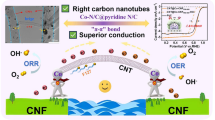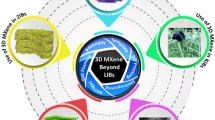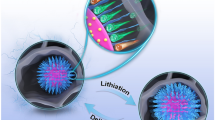Abstract
Three-dimensional hybrids of cobalt oxide (Co3O4) and graphene frameworks are fabricated via a facile hydrothermal self-assembly process. By adjusting the time of the hydrothermal treatment, the morphologies of the Co3O4 components can be modified from rods to nanoparticles, which further manifest influences on the electrochemical performance of the hybrids. As the anode in lithium-ion battery, the hybrid loaded with spherical Co3O4 nanoparticles exhibits the highest reversible capacity of 1148 mA h g−1 at 100 mA g−1 for 100 cycles among the three samples. Even at a high current density of 5000 mA g−1, its reversible capacity is still kept at 600 mA h g−1, outperforming the reported hybrids of Co3O4 and graphene.




Similar content being viewed by others
References
Rosa Palacin M (2009) Recent advances in rechargeable battery materials: a chemist’s perspective. Chem Soc Rev 38:2565–2575
Abraham KM (1993) Directions in secondary lithium battery research and development. Electrochim Acta 38:1233–1248
Chabot V, Higgins D, Yu A et al (2014) A review of graphene and graphene oxide sponge: material synthesis and applications to energy and the environment. Energy Environ Sci 7:1564–1569
Li H, Wang Z, Chen L et al (2009) Research on advanced materials for Li-ion batteries. Adv Mater 21:4593
Yang X, Fan K, Zhu Y et al (2013) Electric papers of graphene-coated Co3O4 fibers for high-performance lithium-ion batteries. ACS Appl Mater Interfaces 5:997–1002
Wu Z-S, Ren W, Wen L et al (2010) Graphene anchored with Co3O4 nanoparticles as anode of lithium ion batteries with enhanced reversible capacity and cyclic performance. ACS Nano 4:3187–3194
Wang X, Wu X-L, Guo Y-G et al (2010) Synthesis and lithium storage properties of Co3O4 nanosheet-assembled multishelled hollow spheres. Adv Funct Mater 20:1680–1686
Yuan C, Yang L, Hou L et al (2012) Flexible hybrid paper made of monolayer Co3O4 microsphere arrays on rGO/CNTs and their application in electrochemical capacitors. Adv Funct Mater 22:2560–2566
Xiao X, Liu X, Zhao H et al (2012) Facile shape control of Co3O4 and the effect of the crystal plane on electrochemical performance. Adv Mater 24:5762–5766
Yang S, Feng X, Ivanovici S et al (2010) Fabrication of graphene- encapsulated oxide nanoparticles: towards high-performance anode materials for lithium storage. Angew Chem Int Ed 49:8408–8411
Su S, Guo W, Leng Y et al (2013) Heterogeneous activation of Oxone by CoxFe3−xO4 nanocatalysts for degradation of rhodamine B. J Hazard Mater 244:736–742
Kim H, Seo D-H, Kim S-W et al (2011) Highly reversible Co3O4/graphene hybrid anode for lithium rechargeable batteries. Carbon 49:326–332
Rai AK, Gim J, Ly Tuan A et al (2013) Partially reduced Co3O4/graphene nanocomposite as an anode material for secondary lithium ion battery. Electrochim Acta 100:63–71
Yan J, Wei T, Qiao W et al (2010) Rapid microwave-assisted synthesis of graphene nanosheet/Co3O4 composite for supercapacitors. Electrochim Acta 55:6973–6978
Zhu X-J, Hu J, Dai H-L et al (2012) Reduced graphene oxide and nanosheet-based nickel oxide microsphere composite as an anode material for lithium ion battery. Electrochim Acta 64:23–28
Yao Y, Yang Z, Sun H, Wang S (2012) Hydrothermal synthesis of Co3O4-graphene for heterogeneous activation of peroxymonosulfate for decomposition of phenol. Ind Eng Chem Res 51:14958–14965
Li B, Cao H, Shao J, Li G (2011) Co3O4@ graphene composites as anode materials for high-performance lithium ion batteries. Inorg Chem 50:1628–1632
Wang B, Wang Y, Park J, Ahn H et al (2011) In situ synthesis of Co3O4/graphene nanocomposite material for lithium-ion batteries and supercapacitors with high capacity and supercapacitance. J Alloys Compd 509:7778–7783
Dong X-C, Xu H, Wang X-W et al (2012) 3D graphene–cobalt oxide electrode for high-performance supercapacitor and enzymeless glucose detection. ACS Nano 6:3206–3213
Chen W, Li S, Chen C et al (2011) Self-assembly and embedding of nanoparticles by in situ reduced graphene for preparation of a 3D graphene/nanoparticle aerogel. Adv Mater 23:5679–5683
Vickery JL, Patil AJ et al (2009) Synthesis and characterization of layer-aligned poly (vinyl alcohol)/graphene nanocomposites. Adv Mater 21:2180–2184
Li X, Huang X, Liu D, Wang X et al (2011) Synthesis of 3D hierarchical Fe3O4/graphene composites with high lithium storage capacity and for controlled drug delivery. J Phys Chem C 115:21567–21573
Wu Z-S, Yang S, Sun Y et al (2012) 3D nitrogen-doped graphene aerogel-supported Fe3O4 nanoparticles as efficient electrocatalysts for the oxygen reduction reaction. J Am Chem Soc 134:9082–9085
Li C, Shi G (2012) Three-dimensional graphene architectures. Nanoscale 4:5549–5563
Sevincli H, Topsakal M, Durgun E et al (2008) Electronic and magnetic properties of 3 d transition-metal atom adsorbed graphene and graphene nanoribbons. Phys Rev B 77:195434
Cao X, Shi Y, Shi W et al (2011) Preparation of novel 3D graphene networks for supercapacitor applications. Small 7:3163–3168
Pappas GS, Ferrari S, Wan C (2015) Recent advances in graphene-based materials for lithium batteries. Curr Org Chem 19:1838–1849
Hao W, Chen S, Cai Y, Zhang L et al (2014) Three-dimensional hierarchical pompon-like Co3O4 porous spheres for high-performance lithium-ion batteries. J Mater Chem A 2:13801–13804
Tao L, Zai J, Wang K et al (2012) Co3O4 nanorods/graphene nanosheets nanocomposites for lithium ion batteries with improved reversible capacity and cycle stability. J Power Sources 202:230–235
Xiang C, Li M, Zhi M et al (2013) A reduced graphene oxide/Co3O4 composite for supercapacitor electrode. J Power Sources 226:65–70
Hummers WS Jr, Offeman RE (1958) Preparation of graphitic oxide. J Am Chem Soc 80:1339–1344
Jiang J, Liu J, Ding R et al (2011) Large-scale uniform α-Co(OH)2 long nanowire arrays grown on graphite as pseudocapacitor electrodes. ACS Appl Mater Interfaces 3:99–103
Wang H, Robinson JT, Diankov G et al (2010) Nanocrystal growth on graphene with various degrees of oxidation. J Am Chem Soc 132:3270–3271
Li B, Cao H, Shao J et al (2011) Co3O4@ graphene composites as anode materials for high-performance lithium ion batteries. Inorg Chem 50:1628–1632
Liang Y, Li Y, Wang H et al (2011) Co3O4 nanocrystals on graphene as a synergistic catalyst for oxygen reduction reaction. Nat Mater 10:780–786
Hardin WG, Slanac DA, Wang X et al (2013) Highly active, nonprecious metal perovskite electrocatalysts for bifunctional metal–air battery electrodes. J Phys Chem Lett 4:1254–1259
Acknowledgements
This work was financially supported by 973 Program of China (2014CB239701 and 2012CB933404), the Natural Science Foundation of China (61235007, 61575121, 21572132, and 21372155), Shanghai Leading Academic Discipline Project (J51503), Shanghai Shu Guang Project (11SG54), Shanghai Talent Development Funding (201335), Professor of Special Appointment at Shanghai Institutions of Higher Learning, MPI-SJTU Partner Group Project for Polymer Chemistry of Graphene Nanoribbons, and Science and Technology Commission of Shanghai Municipal (12JC1404900). We also thank the Instrumental Analysis Center of Shanghai Jiao Tong University for providing some measurements.
Author information
Authors and Affiliations
Corresponding author
Ethics declarations
Conflict of interest
The authors declare that they have no conflict of interest.
Additional information
S. Han and C. Wang contributed equally to this work.
Electronic supplementary material
Below is the link to the electronic supplementary material.
Rights and permissions
About this article
Cite this article
Han, S., Wang, C., Huang, Y. et al. Graphene frameworks supported cobalt oxide with tunable morphologies for enhanced lithium storage behaviors. J Mater Sci 51, 4856–4863 (2016). https://doi.org/10.1007/s10853-016-9790-1
Received:
Accepted:
Published:
Issue Date:
DOI: https://doi.org/10.1007/s10853-016-9790-1




